 |
 |
 |
| |
Acute hepatitis C in men who have sex with men (MSM) is not only confined to those infected with HIV and they continue to increase
|
| |
| |
Reported by Jules Levin
CROI, Feb 2007, Los Angeles
They found 25 new cases of HCV among a population of 3907 MSM in Brighton, UK who previously were HCV-Ab negative. 13 of these cases were diagnosed in 2006, an increasing trend as only 2 were diagnosed in 2003, 4 in 2004, and 6 in 2005. Of note 9 of the 25 did not have HIV (5) or had unknown HIV status HIV (4), and 8 of the 9 eventually acquired HIV suggesting a group with risky behavior. The authors summarize in their abstract: There has been, and continues to be a significant increase in acute HCV in MSM. Contrary to current evidence, this phenomenon is not exclusively in MSM with HIV. This would suggest that routine HCV testing is required in all MSM presenting to sexually transmitted disease (STD)/HIV centers. The interesting thing for me is that all of these studies have come from Europe, mostly the UK but there has been no reporting on this question in the USA. Of note, someone from Emory University did come to the microphone after this talk and discussed her cases, but where are the reports from the USA? Another interesting point, just because you could have undetectable HIV RNA and high CD4 count one can still have high HCV viral load which may facilitate sexual transmission. I think a number of US thought leaders question that HCV is sexually transmitted at concerning rates in the USA, but I question that opinion. I think there is a serious HCV transmission risk caused by risky sexual behavior, incident drug use, and the presence of STDs and HIV.
Richardson summarized: the rate of new HCV infections has increased, HIV+ status increased risk for acquiring HCV by 13 times, but a substantial number of new infections occurred in individuals previously HIV-negative or with unknown status. He recommended regular screening of all HIV+ MSM for HCV and consider screening HIV-negative MSM for HCV although this would require further prospective study. He reported that unprotected anal intercourse, high numbers of sex partners, and the presence of sexually transmitted infections appeared to contribute to acquiring HCV. Of interest he did not report the use of recreational drugs among the individuals who acquired HCV. He also reported that very often ALT was normal and CD4 count was high at the time of HCV diagnosis. At the end he talked a little about possible explanations for HCV transmission among MSM: increasing high-risk sexual behavior given the number of STI outbreaks in the UK; does HIV predispose to HCV transmission, to this he said there is data that HCV/HIV coinfected men have higher HCV viral loads in their semen than men who only have HCV; HIV+ individuals with HCV may have high HCV RNA. He speculated that serosorting may play a role.
Someone from Emory University in Atlanta commented at the microphone that in their population of HIV+ men, a vast majority have syphilis or herpes at the time they have both incident HIV & HCV.
Daniel Richardson1, Martin Fisher1, Caroline Sabin2 (1Dept of Medicine, Brighton & Sussex University Hospitals, Brighton, UK; 2Dept of Primary Care and Population Sciences, Royal Free and University College Hospital Medicak School, London, UK). Daniel Richardson the data in an oral presentation at CROI.
Richardson provided this introductory information. Historically, IVDU was believed to drive hepatitis C (HCV) transmission. However, some sexual transmission of HCV was first observed in the 1990s among discordant heterosexual couples where a partner had chronic HCV, and recently about 14 large cohorts among HIV-infected MSM suggested there was some transmission in this group as well. Transmission in this group appears to be associated with high risk sexual behavior such as unprotected anal sex, use of sex toys and fisting, other sex transmitted infections in particular Chlamydia and gonorrhea and nonintravenous recreational drug use, in particular intranasal cocaine use. However, the risk among HIV-negative nonintravenous drug using MSM is currentlyunknown.
STUDY AIMS
To describe incidence of HCV among HIV+ and HIV-negative MSM who are not IVDUs, and the changes in incidence over time as they hypothesize that this was increasing.
Brighton is a seaside holiday town on the South coast of the UK with a population of only 250,000 people. But what makes Brighton interesting is the large number of MSMS that live there.
Anonymous HIV testing done in gay venues in Brighton have suggested an HIV prevalence rate of 13.7% (data on his slide said there are 25,000 MSMs in Brighton), and only 66% of this population are aware they are HIV+. There are large numbers of sex transmitted infections diagnosed in Brighton, and recently had outbreaks of syphilis and lymphogranulomoeveneriam (probably misspelled this). The city has only 1 STD/HIV clinic making study of this cohort relatively easy.
CURRENT GUIDELINES FOR HCV SCREENING IN MSM
This is interesting. Current guidelines in the UK are to screen for HCV in HIV+ at diagnosis, prior to starting HAART, and subsequently according to risk. And among HIV-negatives only if they have had risky behavior: IVDUs, sex workers, tattoo recipients, alcoholics, and ex-prisoners. However, due to concerns about the high-risk population they have been screening all MSM for HCV on a yearly basis at the Brighton HIV/STD clinic since 2000 regardless of their HIV status.
STUDY METHODS
Analysis included all MSM with at least one HCV-Ab negative test since 2000. Follow-up counted from date of first HCV-Ab negative test until (i) first HCV-Ab positive test, or the (ii) last clinic visit.
Patient follow-up was split into a series of consecutive one month periods. HIV status was determined at the start of each month depending on the status from previous month.
They used Poisson regression to assess impact of HIV status at the start of the month and calendar year on rate of new HCV infections. They excluded MSM with history of IVDU.
CO-INCIDENT INFECTIONS
Because there were a small number of MSM diagnosed with HIV & HCV on the same date they conducted two analyses. The main analysis was assuming they contracted HCV first (HIV status at start of month of infection was assumed to be negative/unknown). Then a sensitivity analysis where they assumed they acquired HIV first.
RESULTS
Identified 7169 MSM were seen during the study period
3907 were eligible for the study as they had at least 1 negative HCV-Ab test.
--25 MSM had an incident HCV infection according to their definition. Of note, 121 of these MSM had an incident HIV infection.
Incidence (95% CI) of HCV Stratified by Calendar Year
During the first 3 years not many HCV tests were performed (2000-2002), but since then they have done many tests in keeping with many other large European cohorts. In 2006 they had 13 incident HCV infections, 0 in years 2000-2002, 2 in 2003, 4 in 2004, and 6 in 2005. Total 25 cases.
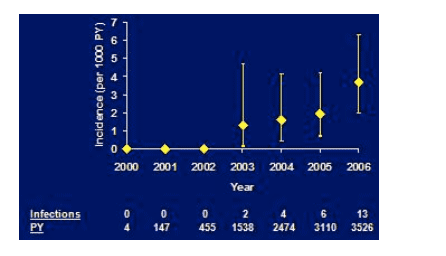
Incidence (95% CI) of HCV Stratified by HIV Status
9 out of the 25 HCV+ cases were either negative (5) for HIV or status was unknown (4) at the time of the HCV test. Of note, 8 of the 9 subsequently acquired HIV-infection and the other one was lost to followup.
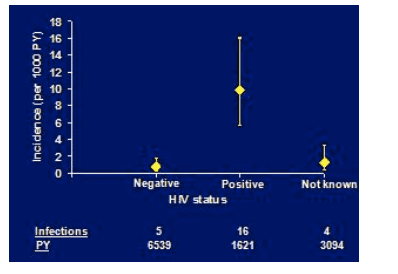
Incidence (95% CI) of HCV Stratified by HIV Status
After they superimposed the incidence of HCV stratified by HIV status with the main analysis and the sensitivity analysis, they see very little difference between these 2 analyses.
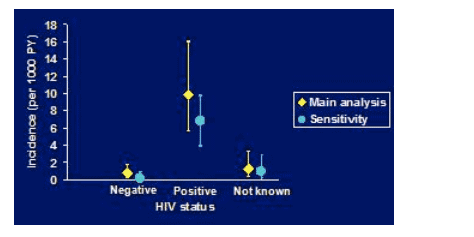
Incidence (95% CI) of HCV Stratified by HIV Status and Year
The incidence of HCV among HIV+ was "dramatically" higher among HIV+ than HIV-negatives are unknown, however the trend among the HIV-negative & unknown is increasing the numbers are too small to be significant. It should be noted these men will not be followed by regular function tests as will be the HIV group.
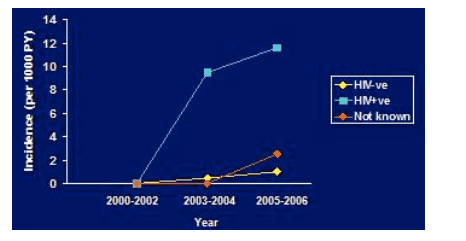
RESULTS from Poisson Regression Analysis - main analysis (HCV first)
HIV+ men are 12.9 times more likely to acquire HCV than HIV-negative men. If you adjust by year there is no difference. There is a 56% increase in incidence of HCV per year and if adjusting for HIV status there is no difference.
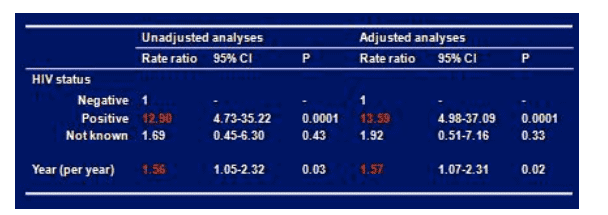
Sexual Behavior of 25 MSMs with Incident HCV
HCV-infected men report "high numbers" of sex partners, and a "relatively large number" of sexually transmitted infections. And the vast majority report unprotected anal intercourse at the time of their HCV diagnosis. By visual observation of table below 12 individuals had 2 partners, 6 had 3-10 partners, and 1 had 10 or more; 10 had 1 STI, 6 had 2 or more infections; 20 had unprotected anal intercourse.
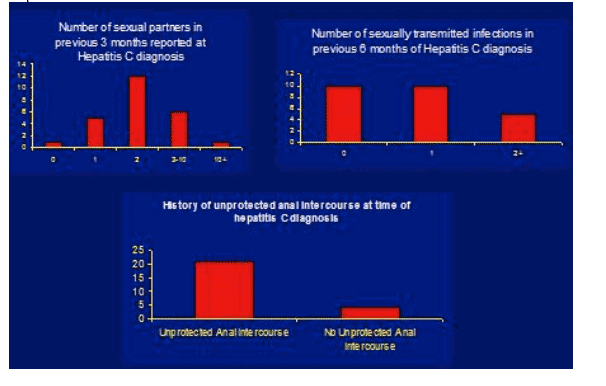
Immunological & Biochemical Parameters of MSMs with HCV
All (n=16) had over 200 CD4s at time of HCV diagnosis and about 15 had >400 CD4s. ALT in MSM (n=25), although majority had raised ALT at time of HCV diagnosis a significant proportion had normal ALT.
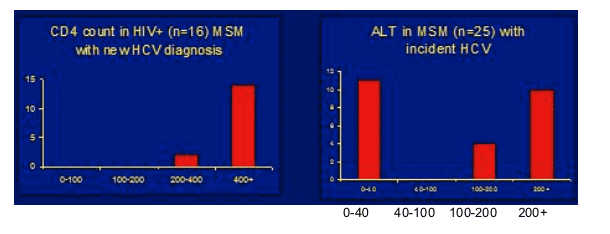
|
| |
|
 |
 |
|
|